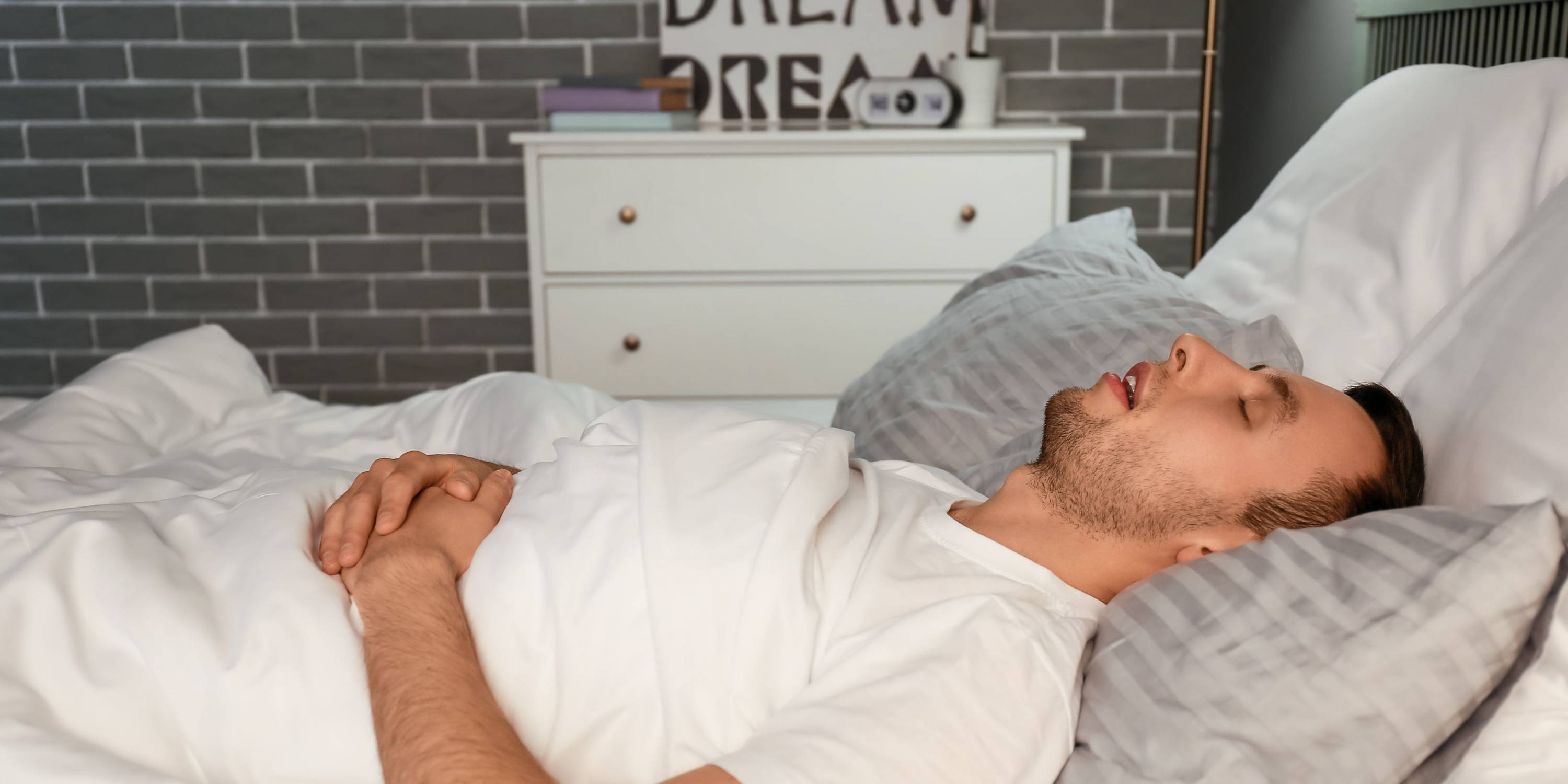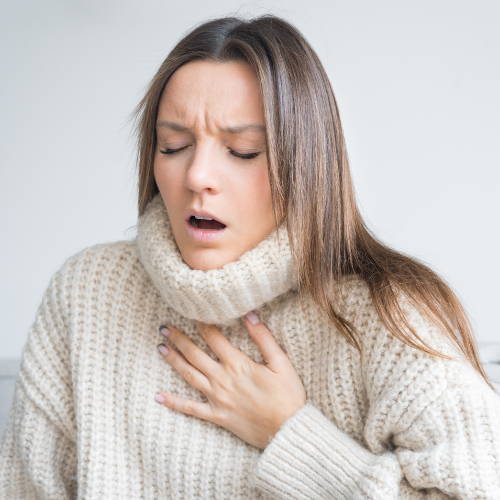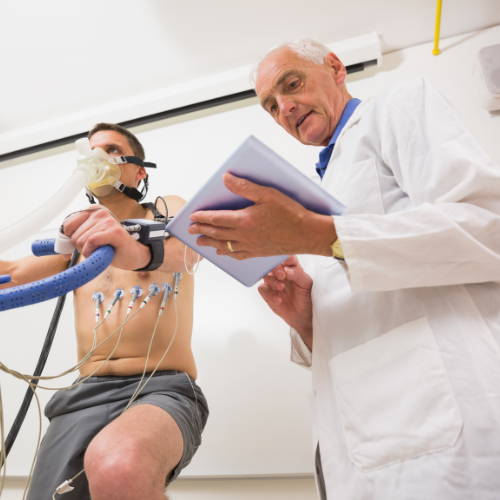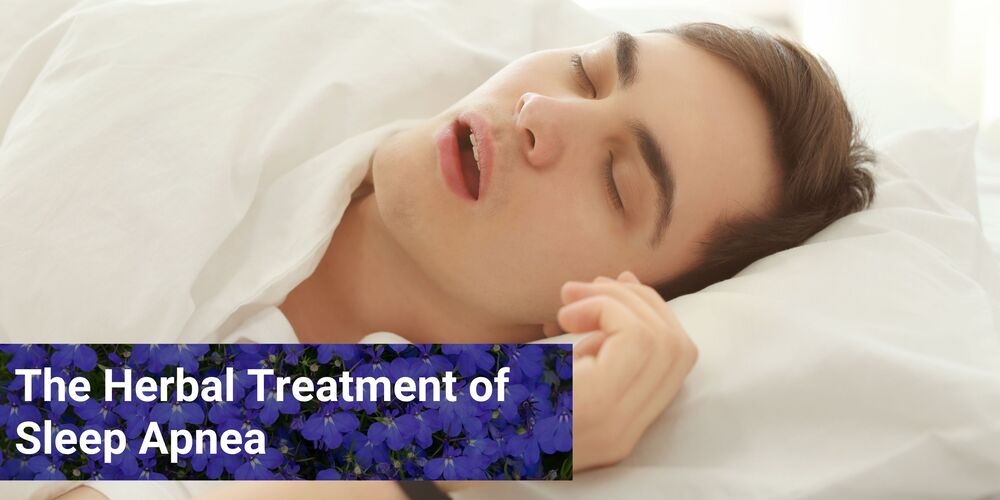El tratamiento a base de hierbas de la apnea del sueño
El tratamiento a base de hierbas de la apnea del sueño
Steven R. Frank , febrero de 2021

La apnea del sueño es uno de los problemas de alteración del sueño más comunes en Estados Unidos. Arruina el sueño de 25 millones de estadounidenses conocidos y probablemente millones más de enfermos no diagnosticados. La condición impide que la persona que duerme entre en el sueño REM y Delta, lo que hace que se sienta ansioso, irritable y cansado durante el día. Las alteraciones y privaciones prolongadas del sueño tienen algunas consecuencias muy graves para la salud.
Cuando se diagnostica, normalmente se le dice al paciente que pierda peso, beba menos alcohol y deje de fumar. La ineficacia de esta sugerencia debería ser bastante obvia. Más allá de eso, se ofrece cirugía, aunque es dolorosa y ha tenido un éxito limitado. Puede resultar difícil dormir con las boquillas dentales y los efectos a largo plazo sobre la alineación de los dientes son cuestionables. Otra opción común es la CPAP. Esta máscara de aire forzado, usada durante el sueño, asegura una inhalación adecuada. Sin embargo, la experiencia ha demostrado que el 60% de los pacientes no pueden tolerar la mascarilla y finalmente dejan de usar el equipo. Además, algunos usuarios desarrollan infecciones respiratorias a causa de la mascarilla.
Lo que se presenta aquí es un enfoque novedoso que es mucho menos intrusivo físicamente que la cirugía o un aparato dental y mucho más cómodo que la CPAP. Estos dispositivos y técnicas primitivos abordan los síntomas del problema y dejan la causa sin abordar. La causa, cuando se aborda de manera sucinta, se puede mitigar hasta el punto en que no se perturbe el sueño.
Causa de la condición
Antes de evaluar las “soluciones”, consideremos qué está causando la afección. Cuando empezamos a conciliar el sueño, pasamos de la etapa uno (somnolencia) a la etapa dos del sueño. La segunda etapa del sueño es la etapa de transición desde la cual entramos en REM (movimiento ocular rápido).
El sueño REM es donde soñamos.
Soñar es fundamental para dormir bien por la noche. Cuando entramos en la etapa dos del sueño en preparación para soñar, la actividad muscular se inhibe (bloquea). A esto se le llama “ inhibición del tono muscular ”. Esta función ocurre de manera normal y apropiada para evitar que el soñador represente físicamente los movimientos de sus sueños.
El primer problema es que la inhibición de las señales del cerebro a los músculos esqueléticos tiende a reducir inadvertidamente la señal que le indica al diafragma que respire. En pacientes con apnea del sueño, al entrar en la etapa 2 del sueño, la respiración se detiene (apnea del sueño significa cese de la respiración). Los músculos del paladar blando de la boca también se debilitan. Esto permite que el paladar blando se hunda.
Sin embargo, ten en cuenta que este es el mismo paladar blando que tienes durante el día y no te causa problemas mientras estás despierto. No “cae” simplemente en las vías respiratorias.
Al entrar en la etapa dos del sueño, se reduce el tono muscular que mantiene el paladar blando fuera de las vías respiratorias. Esto permite que el paladar blando se hunda ligeramente hacia las vías respiratorias. Mientras esto sucede, la misma inhibición del tono muscular está provocando una atenuación de las señales al diafragma. El resultado es que la respiración se vuelve más superficial debido a una intensidad de señal insuficiente a los músculos diafragmáticos. En quienes padecen apnea del sueño, la respiración se detiene.
Cuando cesa la respiración, el nivel de oxígeno en sangre disminuye y los niveles de dióxido de carbono aumentan. En un individuo joven y sano, esto provocaría una respiración más fuerte y profunda del sistema de control que regula estas actividades. En un individuo mayor, la reducción de la respiración provoca un desequilibrio significativo en los gases sanguíneos y, con la falta de señal al diafragma, el desequilibrio alcanza un punto crítico.
En este punto, entra en juego el sistema de respaldo de seguridad. Cuando los niveles de gases en sangre se desequilibran demasiado, el cerebro interviene y hace que el cuerpo realice una inhalación grande e inmediata. Esta rápida inhalación provoca una gran diferencia de presión en la faringe y literalmente succiona el paladar blando y caído hacia las vías respiratorias. Esto obstruye el flujo de aire y provoca un fuerte "SNORT" que despierta parcial o totalmente al sujeto.
La mayoría de las veces, el sujeto no está completamente despierto y, por lo tanto, ni siquiera es consciente de que esto está sucediendo. Aun así, la acción perturba su sueño lo suficiente como para que vuelvan a la etapa 1 del sueño. La excitación mental causada por la reacción del "punto de alarma" del cerebro devolverá al durmiente a un nivel más bajo de somnolencia.
Al despertar o regresar a la etapa 1 del sueño, se libera la inhibición del tono muscular para entrar en la etapa dos del sueño y la respiración comienza nuevamente de una manera algo normal. A medida que el sujeto comienza a quedarse dormido nuevamente, pasa a la etapa dos, el tono muscular cae, el paladar blando se hunde, la señal al diafragma disminuye y el ciclo se repite. Los despertares resultantes de resoplidos generalmente ocurren aproximadamente cada 1 a 5 minutos.
Este ciclo repetitivo sirve para impedir que la persona que duerme entre en REM y, en algunos casos, también puede inhibir la transición al sueño Delta y Theta. Es esta alteración del sueño la que provoca las consecuencias para la salud de la apnea del sueño.
La solución
Si la respiración fuera lo suficientemente profunda, entonces el cerebro no exigiría una inhalación rápida y el paladar blando NO sería succionado hacia las vías respiratorias. No se produciría ningún resoplido resultante que despierte al durmiente. La solución adecuada es acentuar (aumentar) la capacidad del cerebro para comunicarse con el diafragma de modo que se mantenga una respiración constante durante toda la noche.
Seguro que es beneficioso para fortalecer los músculos del paladar blando. Sí, es ventajoso reducir la tensión muscular en el cuello ya que los nervios de C3, C4 y C5 viajan a través de esta área y finalmente se convierten en el nervio frénico que da servicio al diafragma. Ambas cosas harán una mejora notable en la condición. De hecho, algunos alimentos como los productos de trigo y el queso no deben consumirse cerca de la hora de acostarse, ya que pueden provocar congestión, lo que agrava la afección. Sin embargo; el impacto más dramático puede lograrse mediante la administración de sólo unas pocas hierbas comunes.
Recordando que la causa fundamental de esta cascada de eventos es causada por una disminución de la señal del cerebro al diafragma, pasamos a Lobelia. Lobelia, cuando se usa en pequeñas dosis, actúa como estimulante respiratorio. Se ha utilizado durante miles de años para tratar afecciones respiratorias.
Esta hierba, cuando se toma antes de acostarse, puede aumentar el nivel de respiración en reposo lo suficiente como para evitar la peligrosa caída en el nivel de oxígeno en sangre que se produce tras la inhibición muscular. Lobelia puede mantener una respiración profunda y constante durante el período de transición del sueño de la etapa 2. Esto evita que el cerebro solicite una inhalación rápida que succionaría el paladar blando y despertaría al durmiente.
El tomillo se ha utilizado tradicionalmente para potenciar la actividad pleural. De hecho, mejora la capacidad de los pulmones para intercambiar CO2 por oxígeno y contribuye de manera excelente a mantener una amplitud respiratoria suficiente.
Para completar la combinación, la manzanilla ayuda al sujeto a relajarse y Cramp Bark ayuda a que los músculos trapecios superiores se relajen. Es beneficioso relajar los músculos trapecios superiores, ya que tienden a tensarse durante el día en una "respuesta al estrés". Los nervios que emanan de C3, C4 y C5 pasan a través de esta región muscular en el plexo braquial para formar el nervio frénico. Lo mejor es tener una transmisión nerviosa sana, ya que es este nervio el que da servicio al diafragma.
Se ha demostrado que esta combinación de hierbas tomadas antes de acostarse alivia la apnea del sueño en la mayoría de los casos. Es interesante observar que cuando una persona que sufre de apnea del sueño y no ha sido tratada prueba esta combinación, el alivio se siente desde la primera noche. No se requiere ningún acondicionamiento previo para que las hierbas aumenten el nivel respiratorio, la relajación de los músculos esqueléticos y la eficiencia del intercambio de gases.
Lo que sucede a continuación es bastante interesante. El cuerpo se da cuenta de que ahora puede acceder al sueño REM. La privación de REM causada por la condición de apnea preexistente ha generado una deficiencia y el sujeto experimentará un efecto conocido como "rebote de REM". Este "soñar demasiado" en realidad puede hacer que el sujeto se sienta menos descansado de lo normal. El cuerpo restablecerá un patrón de sueño normal en un par de semanas y los resultados generales serán un descanso muy superior. Este rebote de REM no se observa en pacientes que hacen la transición de CPAP a la solución a base de hierbas, ya que no se les ha privado de REM.
Un producto para aliviar la apnea del sueño está disponible en cápsulas de Nature's Rite en www.MyNaturesRite.com

Consiga el mejor sueño de su vida mediante una respiración óptima
Acerca de Steve
 El Sr. Frank comenzó su carrera diseñando equipos médicos modernos para grandes corporaciones. Luego pasó al desarrollo de equipos experimentales especializados para investigadores médicos.
El Sr. Frank comenzó su carrera diseñando equipos médicos modernos para grandes corporaciones. Luego pasó al desarrollo de equipos experimentales especializados para investigadores médicos.
Ahora, después de muchos años de trabajar con la medicina alopática, el Sr. Frank encontró su camino hacia la medicina herbaria. Estudiar con herbolarios, médicos, quiroprácticos y fisioterapeutas llevó al Sr. Frank al desarrollo de una serie de productos para el tratamiento de lesiones y enfermedades físicas comunes utilizando técnicas médicas naturales. A partir de miles de años de remedios herbales tradicionales y cientos de años de fisiología moderna y estudios curativos, ha sintetizado algunos productos naturales que complementan las direcciones y acciones del cuerpo humano curativo.
Estos productos abordan cuestiones de: alteraciones del sueño, reparación de tejidos lesionados, control de infecciones y equilibrio hormonal. Años de estudios clínicos, trabajo de laboratorio y experiencia en tratamientos han demostrado la utilidad de estos productos.
El Sr. Frank ahora ofrece estos productos a través de Nature's Rite para empoderar a todos los que buscan recuperar y mantener la salud de forma natural.
"Después de 250 horas de investigación y pruebas, incluyendo entrevistas a cinco expertos en porteo de bebés y caminar más de 100 millas en 15 envolturas, cabestrillos y meh dais, creemos que los portabebés Gemlak son los mejores"

¿ Qué tan buena es tu respiración?
¿Quieres saber el futuro de tu salud y longevidad?
Artículos más populares

12 de abril de 2021

10 de febrero de 2022


Lograr niveles satisfactorios de ejercicio sin agravar el corazón existente.
Comprenda y explore EWOT: ejercicio con oxigenoterapia.
La respiración óptima
Kit de autodominio
Artículos sobre respiración y oxígeno
-
Respiración
-
Oxígeno
- El moho podría estar en su hogar ahora mismo. ¿Estás en riesgo?
- Venza el estrés laboral de la manera correcta
- El mal aliento causa asma: ¡esto es lo que debe hacer!
- Respiración óptima, autismo y desarrollo cerebral
- ¿Por qué respirar mejor? El mal aliento te enferma o te enferma aún más. Aprenda a respirar mejor ahora
- Cura tus problemas respiratorios con ejercicios de respiración
Obtenga ayuda personal para mejorar su salud
y vitalidad.





